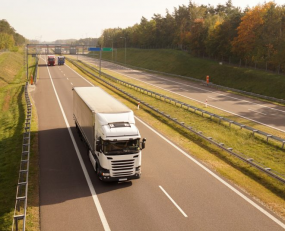
In April 2019, Uber Freight announced its operational debut in Europe. The Netherlands was the first European market Uber Freight entered, followed by Germany. Last week the company announced it is now expanding its European footprint to Poland. The Uber Freight app connects carriers with loads to haul, offering upfront pricing, fast payment, and the ability to book loads with a few clicks. For shippers, Uber Freight unlocks access to a vast network of carriers as well as real-time visibility into their supply chain.
The decision to establish the company’s presence in Poland was mainly based on the country’s significance for international road transport in Europe. According to Ti’s market sizing, Poland is the fourth largest international market. Having already entered into the two largest international road freight markets this year, Germany and the Netherlands, the expansion into Poland shouldn’t come as a surprise. It is worth highlighting that Uber Freight decided to bypass Spain, the third largest international road freight market according to Ti’s market sizing, suggesting there are other factors influencing the decision. Daniel Buczkowski, Uber Freight’s Head of European Expansion, commented in this regard that the projected economic development of Poland, driven by the growing consumption, growth of the e-commerce sector and the growing number of retail outlets, is another factor that motivated the company’s decision to enter the Polish market.
In order to compete in the increasingly competitive freight brokerage market in Europe, Uber Freight needs to achieve scale. The Q1 2019 earnings statement revealed that Uber Freight had contracted with over 36,000 carriers and more than 400,000 drivers and has served over 1,000 shippers. However, it didn’t reveal how many of these have been contracted in Europe. Getting more truck drivers and shippers on its app means competing for scale and market share with already established digital freight platforms, such as InstaFreight, Everoad and sennder.
The Berlin-based digital freight forwarding company InstaFreight, for instance, currently aggregates over 10,000 carriers and over 2,000 active customers on its platform, making it one of the most successful digital start-ups in the European road freight market. The Berlin-based sennder is another competitor, connecting over 7,500 carriers across its platform. Having raised a further $70m in a Series C round of funding in July this year at a $300m valuation, sennder is taking on the antiquated logistics market with its AI driven digital platform and represents one of the most significant players in the European digital road freight market. The French-based Everoad in turn has 6,000 carries on its platform and has recently signed a contract with the French mass-retailer Groupe Casino, worth a total of €100m.
This speaks to a very crowded market in which Uber Freight will have to find a sweet spot and develop its unique value proposition. It might adopt the same strategy as in the U.S., i.e. mainly focusing on market share and not on profits. According to a Morgan Stanley & Co. analysis, in the U.S. Uber Freight has been sharing nearly all the revenue from its digital freight-matching platform with its carriers in an effort to capture greater share. If Uber Freight adopts the same strategy in Europe as in the U.S., which is prioritizing supply and demand density over profits, then it is to be expected that it will offer freight rates below market value to undercut its competitors. This is certainly something that will keep both incumbents and new digital entrants in the European road freight market on their toes.
Source: Transport Intelligence, November 5, 2019
Author: Violeta Keckarovska